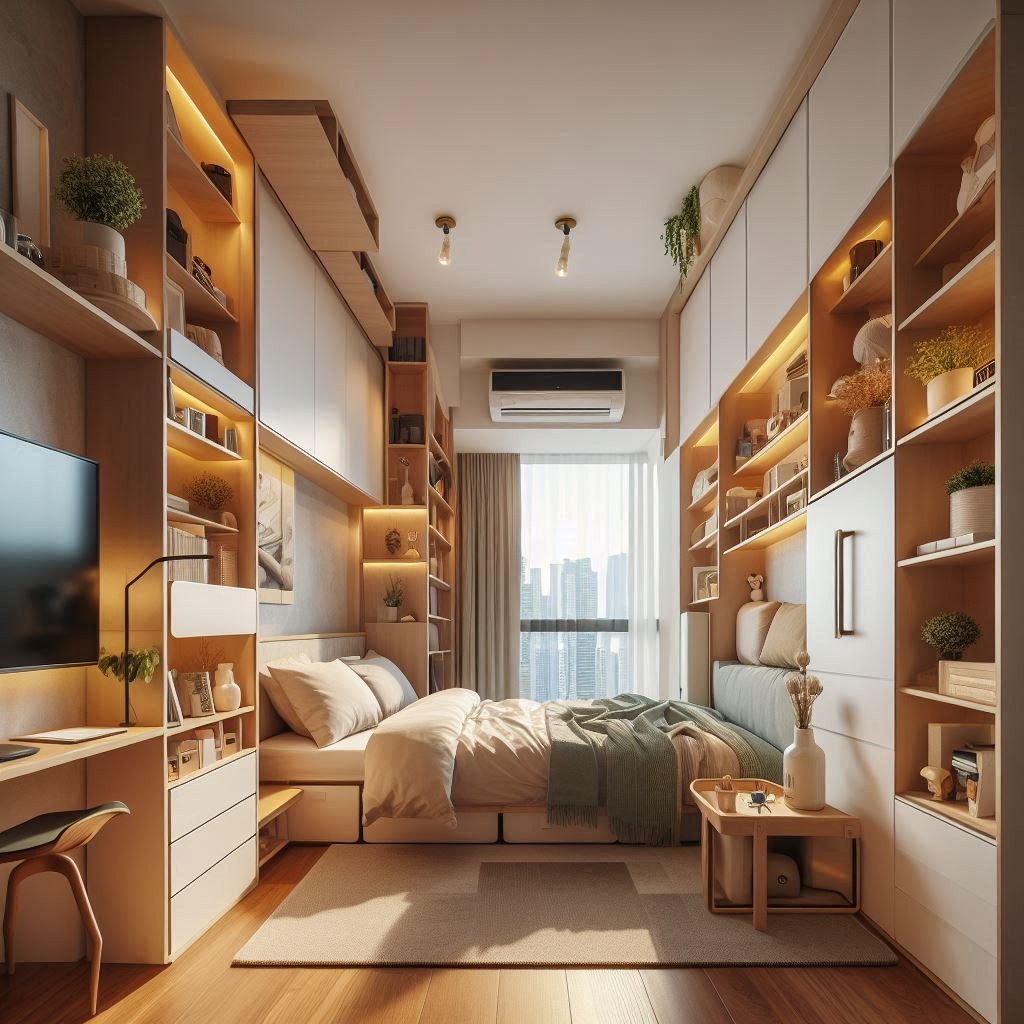
Creating functional and stylish storage in a small flat requires creativity, thoughtful planning, and multipurpose solutions. Below is a concise guide to help you maximise every inch of your living space without sacrificing aesthetics:-
- Assess Your Space and Needs
Start by taking stock of your belongings and analysing your flat’s layout.
- Measure Your Rooms: Note the height, width and depth of each area, including hallways, corners and awkward nooks.
- Identify Clutter Hotspots: Figure out where items tend to pile up, entryway shoes, kitchen gadgets or office supplies.
- Prioritise Items: Distinguish between daily essentials (like kitchenware or work materials) and seasonal or decorative pieces that can be stowed away.
Before purchasing organisers, ensure they fit your exact needs. Additionally, try to clear out unused items every few months; by reducing what you own, you’ll need less storage overall.
- Embrace Vertical Space
When floor area is limited, think upwards. Vertical storage keeps the floor clear and makes rooms feel more spacious.
- Floating Shelves: Slim, wall-mounted shelves above a desk or sofa create display spots for books, plants or toiletries without bulk.
- Tall Cabinets or Bookcases: Choose units that reach near the ceiling. Even a shallow shelving unit (12–15 cm deep) can house decorative items, DVDs or office files.
- Wall Hooks and Pegboards: In entryways or kitchens, hooks can hold coats, bags or pans. Pegboards allow you to rearrange hooks and baskets for utensils, tools or craft supplies.
- Over-Door Racks: Use the backs of doors to hang shoe organisers, jewellery displays or cleaning-product caddies, keeping things accessible but out of sight.
Vertical storage frees up floor space and draws the eye upwards, creating the illusion of higher ceilings.
- Multipurpose and Modular Furniture
Furniture that serves multiple functions is essential in a small flat.
- Storage Ottomans and Benches
- Hidden Compartments: Use an ottoman or bench with a removable top to store blankets, magazines or off-season clothing.
- Entryway Benches: Benches with cubbies underneath hold shoes. Slip baskets into each cubby to corral scarves, hats or umbrellas.
- Sofa Beds and Daybeds
- For Guests: A sofa bed provides sleep space without dedicating a whole room to a bed.
- Under-Frame Drawers: Some daybeds come with built-in drawers for bedding, pillows or seasonal garments.
- Fold-Away Tables
- Drop-Leaf or Wall-Mounted Tables: These offer a dining or work surface when needed, then fold away to keep the room uncluttered.
- Shelf/Desk Combos: A hinged panel can act as both a shelf and a desk, folding up to look like simple wall art when not in use.
- Lofted Beds and Under-Bed Desks
- Raised Sleeping Zone: If ceiling height allows, lofting the bed creates space underneath for a desk, seating area or storage shelves.
- Murphy Beds with Desks: These fold-away beds often integrate a desk panel that flips down when the bed is stowed up, combining a sleeping area and home office in one footprint.
- Utilise Underutilised Nooks
Small flats frequently have odd spaces, under windows, around radiator covers or in corners, that can become clever storage spots.
- Window-Seat with Drawers: Fit a bench with lift-top seats or drawers beneath windows to store linens, books or board games.
- Radiator Shelf: Place a shallow shelf above a radiator to hold books, framed photos or small plants. Slim baskets on that shelf can catch mail and keys.
- Corner Shelving: Triangular shelves snugly fit corners, ideal for displaying ornaments or holding toiletries in a small bathroom.
- Above-Cupboard Storage: If there’s a gap between kitchen units and the ceiling, use decorative baskets or bins for less-used cookware, seasonal serveware or bulk pantry items.
- Over-Toilet Cabinets: A slim cabinet above the toilet in the bathroom holds towels, toiletries and cleaning supplies in otherwise wasted vertical space.
By utilising every nook, you keep surfaces uncluttered and maximise storage.
- Make the Most of Under-Furniture Space
Spaces beneath beds, sofas or desks often go unused but can be turned into efficient storage zones.
- Low-Profile Pull-Out Bins: Slideable bins with clear lids keep shoes, winter clothing or off-season linens neatly under the bed. Wheels make them easy to pull out.
- Under-Seat Drawers: Some sofas or chairs allow shallow drawers beneath the seat. Use these for extra throw pillows, craft supplies or children’s toys.
- Clip-On Under-Desk Drawers: These mount conveniently below the desktop to hold stationery, cables or notebooks without using up legroom.
- Closet Floor Organisers: In a small wardrobe, add stackable fabric drawers on the floor for t-shirts, scarves or handbags, keeping folded items visible and accessible.
Purposeful under-furniture storage minimises clutter without enlarging your furniture footprint.
- Stylish Containers and Decorative Pieces
Not everything needs to be concealed: attractive storage can double as décor.
- Woven Baskets and Seagrass Boxes: Place these on open shelves or under coffee tables. They add texture while corralling throws, magazines or electronics.
- Coordinated Accent Boxes: Use matching fabric or lacquered boxes on top of shelves to store paperwork, batteries or kitchen linens.
- Glass Jars and Canisters: In the kitchen, uniform glass jars keep dry goods, like pasta, rice or beans, visible, organised and visually appealing.
- Metal Magazine Holders: Lean these against a wall to store newspapers, sheet music or thin cookbooks neatly.
- Decorative Trunks: A small trunk at the foot of the bed or in the living area can store extra bedding or seasonal items while doubling as a side table.
Choosing containers that complement your colour scheme and décor ensures storage looks intentional rather than an afterthought.
- DIY and Custom Solutions
When off-the-shelf options won’t fit odd dimensions, consider simple DIY or semi-custom projects.
- Floating Nightstands: Attach a sturdy floating shelf to the wall beside your bed. It frees up floor space and can be made to the exact width you need.
- Modular Closet Systems: Even a basic tension-rod shelf can subdivide a closet for shoes above and folded clothes below. Install modular bars, cubbies and shoe racks to match your wardrobe.
- Repurposed Crates and Pallets: Sand and paint wooden crates to stack into a shelving unit. Pallets can become platform beds with cubbies for baskets underneath.
- Magnetic Strips and Chalkboard Paint: In the kitchen, mount a magnetic strip on the backsplash to hold knives or spice tins. Paint part of a pantry door with chalkboard paint for shopping lists and meal plans.
- Custom Under-Stair Drawers (where applicable): If your flat has a staircase, use the triangles beneath the steps to install pull-out drawers for shoes, towels or linens.
DIY solutions let you optimise your unique footprint and often cost less than specialised furniture.
- Room-By-Room Tips
Below are quick suggestions to tackle common clutter hotspots:
8.1 Hallway and Entryway
- Wall-Mounted Cabinet: A shallow cabinet with a drop-down front holds keys, mail and everyday essentials. A small ledge on top is perfect for sunglasses or decorative items.
- Narrow Console Table: Keep one slim table against the wall; store baskets on its lower shelf for gloves, hats and reusable bags.
- Slim Shoe Rack: A tiered shoe organiser no more than 15 cm deep keeps footwear tidy without eating into hallway space.
8.2 Living Area
- Media Console with Cable Management: Choose a TV stand with concealed wiring channels and adjustable shelves to keep consoles and routers neat.
- Nested Side Tables: Smaller tables slide under larger ones when not in use, ideal for entertaining without clutter.
- Corner Cabinets: Install cabinets that fit into corners to store board games, DVDs or extra serveware.
8.3 Kitchen
- Magnetic Knife Strip and Utensil Rail: These clear countertops by keeping knives and cooking tools within arm’s reach.
- Pull-Out Shelves: Install tiered pull-out shelves in lower cabinets so you can reach items at the back without rummaging.
- Over-Sink Drying Rack: An expandable rack above the sink doubles as extra prep space when folded down.
8.4 Bedroom
- Under-Bed Vacuum Bags: Compress bulky items like duvets or off-season clothes into vacuum-sealed bags to save space.
- Headboards with Storage: A headboard featuring cubbies or recessed shelves provides space for books, an alarm clock or decorative objects.
- Wall-Mounted Nightstand Shelf: Mount a small shelf at bedside height to keep essentials off the floor.
8.5 Bathroom
- Over-Door Towel Rack: Hang towels on a rack that hooks over the door to free up wall space inside the bathroom.
- Corner Shower Shelves: Tiered corner shelves store shampoo, conditioner and soap without taking up main shower space.
- Slim Rolling Cart: Tuck a narrow, wheeled cart between the toilet and vanity to hold toilet paper, cleaning supplies and grooming products.
- Keep It Cohesive
A unified look between storage and décor prevents a cluttered appearance, even if you have many items on show.
- Limit Your Palette: Choose baskets, bins and furniture in complementary hues, neutrals or a consistent accent colour, to avoid visual chaos.
- Mix Textures, Not Patterns: Woven baskets combined with metal or wood add interest without overwhelming the eye. Too many patterns at once can feel busy.
- Rotate Seasonal Items: Store out-of-season clothing, décor or linens in under-bed bins or high shelves. Rotating a few pieces per season keeps your space feeling fresh.
- Leave Breathing Room: Resist filling every shelf. Strategic empty spaces let the eye rest and make displayed items look intentional.
- Group in Odd Numbers: When styling open shelving, arrange objects in groups of three or five. For instance, stack two books horizontally with a small vase on top for a tidy vignette.
- Regular Decluttering
Even the best storage setup needs occasional reassessment. As your lifestyle and possessions change, so should your organisation.
- Quarterly Clear-Outs: Every few months, spend a short session deciding what you actually use versus what’s gathering dust. Donate, recycle or discard anything you no longer need.
- Label Containers: For higher or deeper shelves, label boxes and baskets to help you find items without pulling down multiple containers.
- Adjust When Necessary: If a shelf or drawer isn’t working, too small for bins or badly placed, relocate or replace it with a solution that fits better.
- Maintain Balance: As you add new décor items, rearrange open shelving to prevent overcrowding. Take something away before adding another piece.
By routinely clearing out unused possessions and tweaking your storage, you’ll minimise clutter and keep your flat both organised and stylish.
Conclusion
Living in a small flat doesn’t mean living in chaos. By leveraging vertical space, investing in multipurpose furniture, making use of underutilised nooks, selecting attractive containers and decluttering regularly, you can create ample storage without sacrificing style. With thoughtful planning and periodic reassessment, you’ll transform a compact space into an organised, welcoming home, proving that clever storage is as much about creativity as it is about square metres.
I hope this article has given you plenty of inspiration to make the most of your small flat. Whether you’re keen to tackle a DIY storage project yourself or would prefer to call in a professional, you can post your job on Tradesmen.ie and receive competitive quotes from carpenters, joiners, builders and more, making it easier than ever to bring your ideas to life!
Cheers
Oliver Dempsey
Tradesmen.ie
7 June 2025
General Tips for hiring a tradesman
Here are some tips to consider when hiring a tradesman:-
1. Ask for phone numbers of references so that you can check them out
2. Check insurance of the tradesman where insurance is required
3. Hire a suitably qualified architect, building surveyor or building engineer if the job is anything to do with a new build, building renovation or extension
4. Agree on some sort of stage payments for the job. Remember that full payment should not be made until the job is complete and has been inspected by you, and if necessary by a certifier.






